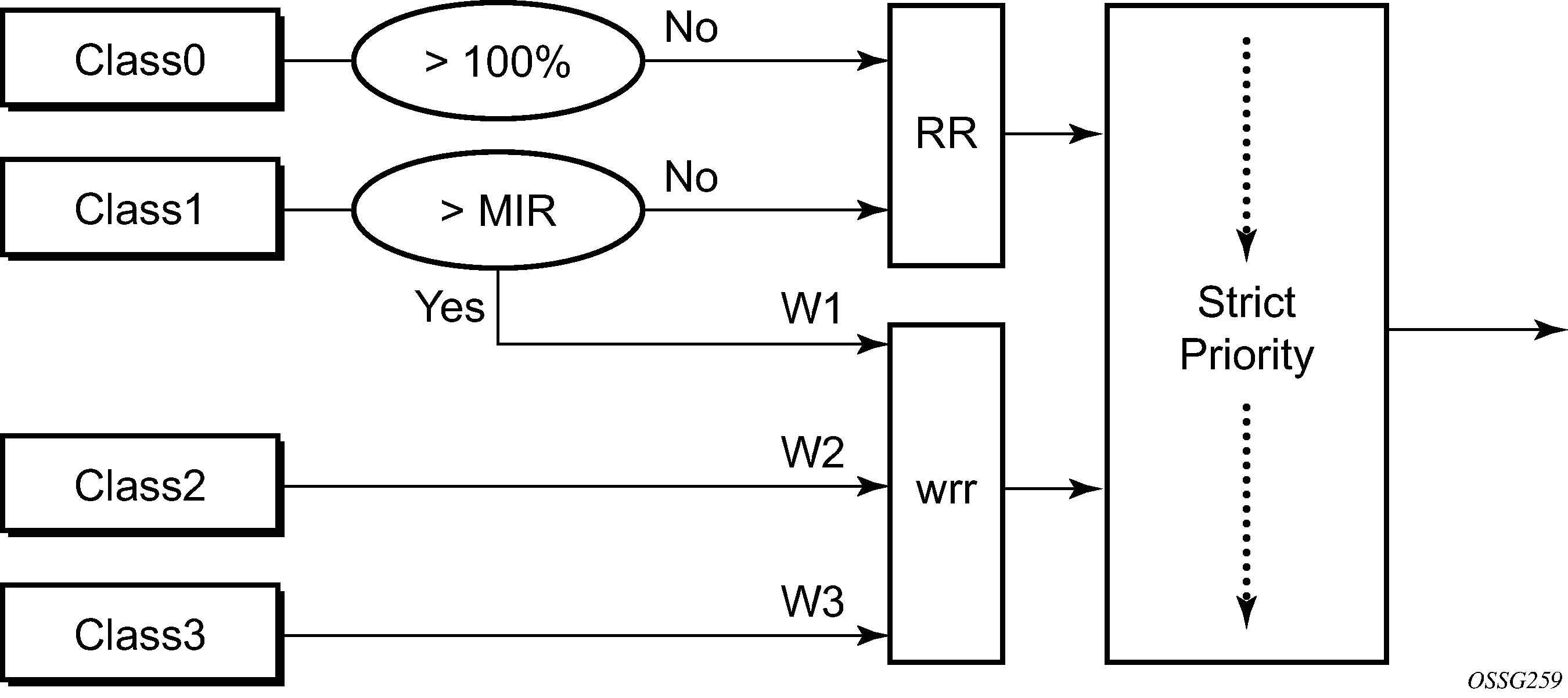If the user enables the multiclass option under an MLPPP bundle, the MDA egress data path provides a queue for each of the four classes of MLPPP. The user configures the required number of MLPPP classes to use on a bundle. The forwarding class of the packet, as determined by the ingress QoS classification, determines the MLPPP class for the packet and therefore which of the four egress MDA queues to store the packet. The mapping of forwarding class to MLPPP class is a function of the user configurable number of MLPPP classes. The default mapping for a 4-class, 3-class, and 2-class MLPPP bundle is shown in Table 1.
| FC ID | FC name | Scheduling priority (default) | MLPPP class 4-class bundle | MLPPP class 3-class bundle | MLPPP class 2-class bundle |
|---|---|---|---|---|---|
7 |
NC |
Expedited |
0 |
0 |
0 |
6 |
H1 |
Expedited |
0 |
0 |
0 |
5 |
EF |
Expedited |
1 |
1 |
1 |
4 |
H2 |
Expedited |
1 |
1 |
1 |
3 |
L1 |
Non-Expedited |
2 |
2 |
1 |
2 |
AF |
Non-Expedited |
2 |
2 |
1 |
1 |
L2 |
Non-Expedited |
3 |
2 |
1 |
0 |
BE |
Non-Expedited |
3 |
2 |
1 |
Table 2 shows a different mapping enabled when the user applies one of three pre-defined egress QoS profiles in the 4-class bundle configuration only.
| FC ID | FC name | Scheduling priority (default) | MLPPP class (MLPPP egress QoS profile 1, 2, and 3) |
|---|---|---|---|
7 |
NC |
Expedited |
0 |
6 |
H1 |
Expedited |
0 |
5 |
EF |
Expedited |
1 |
4 |
H2 |
Expedited |
2 |
3 |
L1 |
Non-Expedited |
2 |
2 |
AF |
Non-Expedited |
2 |
1 |
L2 |
Non-Expedited |
2 |
0 |
BE |
Non-Expedited |
3 |
The MLPPP class queue parameters and its scheduling parameters are also configured by applying one of the three pre-defined egress QoS profiles to an MLPPP bundle.
Table 3 and Figure 1 provide the details of the class queue threshold parameters. Packets marked with a high drop precedence, such as out-of-profile, by the service or network ingress QoS policy are discarded when any class queue reaches the OOP threshold. Packets with a low drop precedence marking, such as in-profile, are discarded when any class queue reaches the max threshold.
| Class 0 | Class 1 | Class 2 | Class 3 | |||||
|---|---|---|---|---|---|---|---|---|
Queue Threshold (in ms @ Available bundle rate) |
Max |
Oop |
Max |
Oop |
Max |
Oop |
Max |
Oop |
2-Class Bundle Default Egress QoS Profile |
250 |
125 |
750 |
375 |
N/A |
N/A |
N/A |
N/A |
3-Class Bundle Default Egress QoS Profile |
50 |
25 |
200 |
100 |
750 |
375 |
N/A |
N/A |
4-Class Bundle Default Egress QoS Profile |
10 |
5 |
50 |
25 |
150 |
75 |
750 |
375 |
4-Class Bundle Egress QoS Profile 1 |
25 |
12 |
5 |
3 |
200 |
100 |
1000 |
500 |
4-Class Bundle Egress QoS Profile 2 |
25 |
12 |
5 |
3 |
200 |
100 |
1000 |
500 |
4-Class Bundle Egress QoS Profile 3 |
25 |
12 |
5 |
3 |
200 |
100 |
1000 |
500 |

Table 4 and Figure 2 provide the details of the class queue scheduling parameters.
| WRR parameters | ||||
|---|---|---|---|---|
4-class MLPPP Egress QoS Profile |
MIR |
W1 |
W2 |
W3 |
Profile 1 |
85% |
<1% |
66% |
33% |
Profile 2 |
90% |
<1% |
89% |
10% |
Profile 3 |
85% |
<1% |
87% |
12% |

Note that all queue threshold and queue scheduling parameters are adjusted to the available bundle rate. If a member link goes down or a new member link is added to the bundle, the scheduling parameters MIR, W1, W2, W3, as well as the per class queue thresholds OOP and max are automatically adjusted to maintain the same values.
Class 0 queue is serviced at MLPPP at available bundle rate. Class 1 queue is guaranteed a minimum service rate but is allowed to share additional bandwidth with class 2 and 3 queues based on the configuration of WRR weight W1.
Class queues 2 and 3 can be given bandwidth guarantee by limiting MIR of class 1 queue to less than 100% and by setting the WRR weights W1, W2, and W3 to achieve the needed bandwidth distribution among all three class queues.
Note that there is one queue per bundle member link to carry link control packets, such as LCP: PPP, and which are serviced with strict priority over the 4 class queues (not shown).
In the default 2-class, 3-class, and 4-class egress QoS profile, the class queues are service with strict priority in ascending order of class number.